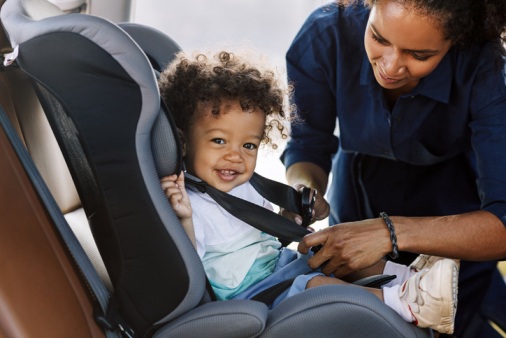The current laws on seat belts and car seats in the UK

What is the punishment for not wearing a seat belt?
If you or someone you are responsible for is not wearing a seat belt, you won’t receive points on your driving licence, but you can be hit with a fine, usually a fixed penalty notice for £100. However, if the case goes to court, the fine for failure to wear a seat belt can be as high as £500.
Who needs a seat belt?
Drivers and adult passengers (14 and up)
Seat belts must be worn by all adults in the car, including the driver, unless they have a specific reason why they should be exempt, and can prove that their exemption is valid. For example, you may not have to wear a seat belt due to a medical reason.
For the purposes of ‘seat belt law’, anyone over the age of 14 is classed as an adult.
All adults in the car are responsible for their own seat belt – so if your thirteen-year-old son is caught not wearing his seat belt in your car, for example, you will be held responsible, whereas he would be the one in trouble if he was fifteen.
Children up to 3 years old
Children of this age cannot travel without a correct child restraint, appropriate to their weight. If the car does not have sufficient restraints, the child cannot travel in it.
The only exception to this is when riding in the back of a licensed taxi which does not provide the proper restraints for a child of this age – in these circumstances, the child may ride unrestrained.
A child in a rear-facing restraint can ride in the front seat of the car, but only if there is no frontal airbag. If the seat has an airbag, it must be deactivated.
Children between ages 3-14
The level of restraint required for children between these ages largely depends on how tall the child is.
Until a child is 135cm (roughly 4’5”) tall or 12 years old, they must ride in a car seat appropriate for their age. However, once the child passes either one of these milestones, he or she can ride using an adult belt without any additional restraint.
Note that the child must only pass one milestone – a 7 year old who is 140cm tall would pass the height threshold, and a 12 year old who is only 130cm tall would pass the age threshold.
Children who are not old or tall enough to use adult belts can do so in certain circumstances. These are:
- In a taxi or privately hired vehicle in which the proper restraint is unavailable;
- Where two occupied child seats prevent the fitting of a third restraint;
- If a short journey is necessary and the correct restraint is unavailable.
Child car seats and restraints
As mentioned above, children must sit in a baby seat or another kind of child restraint when sat in the car until they are at least:
- 12 years old; or
- 135 centimetres tall,
You can choose a child car seat based on the child’s height or weight.
Height-based seats
Height-based seats are known as ‘i-Size’ seats. They must be placed rear-facing until the child is over 15 months old; after this the child can be seated in a forward-facing seat.
You must check the seat to ensure it’s suitable for the height of your child. Only EU-approved height based child car seats can be used in the UK. These have a label showing a capital ‘E’ in a circle and ‘R129’.
Weight-based seats
The sizes of these seats vary according to the weight of the child they are designed to support – names of seats vary from manufacturer to manufacturer, but here is a guide of how seat sizes are generally measured.
- Group 0. Lie-flat or ‘lateral’ baby carriers, rear-facing baby carriers, or a rear-facing baby seat using a harness; for children up to 10kg.
- Group 0+. Rear-facing baby carriers or a rear-facing baby seat using a harness; for children up to 13kg.
- Group 1. A rear- or forward-facing baby seat using a harness or safety shield; for children weighing from 9kg to 18kg.
- Group 2. Rear- or forward-facing child car seat (high-backed booster seat or booster cushion) using a seat belt, harness or safety shield; for children weighing from 15kg to 25kg.
- Group 3. Rear- or forward-facing child car seat (high-backed booster seat or booster cushion) using a seat belt, harness or safety shield; for children weighing from 22kg to 36kg.
These groups are assigned to restraints that have reached the approval standard of UN ECE Regulation 44.04. Only EU-approved weight-based child car seats can be used in the UK. These have a label showing a capital ‘E’ in a circle, an ECE R44 label, as well as the group number or weight of child it was designed to hold.
Seat belt adjusters
Unless a seat belt adjuster bears an ECE R44 label, it is only adequate for comfort purposes, and is not suitable for maintaining safety.
What if my car doesn’t have seat belts?
All passengers must wear seat belts if the car has been fitted with them as standard, or if they have been fitted late. In the case of older or classic cars, which are not fitted with seat belts, passengers can ride without being strapped in but children over 3 are only allowed to sit in the back seats. Any children under the age of 3 are not allowed to ride in a car or other vehicle with no seat belts.
Buses, coaches and minibuses
Seat belts are not a legal requirement in these vehicles, but similarly to cars, they must be worn if provided. Operators of these vehicles are required to notify the passengers either by announcing it to them, or by clearly indicating with signs at each passenger’s seat. Failure by the operator to do so would mean they are breaking the law.
Medical exemption from wearing a seat belt
Those who have legitimate medical reasons to not wear a seat belt can seek exemption. In these circumstances, a medical practitioner would provide a ‘Certificate of Exemption from Compulsory Seat Belt Wearing’, saying that the holder should not be made to wear a belt. The holder would be required to keep this certificate in their vehicle and would need to show it to the police if they’re stopped.
Without this certificate, a driver or passenger cannot be exempt from wearing a seat belt, even if they are pregnant or disabled. If a medical practitioner refuses to grant exemption, they must give a clear reason as to why not. If you wish, you can then seek a second opinion.
A certificate of exemption granted in the UK will bear the EU symbol and will be accepted in any other EU member state.
Other reasons for exemption
There are a number of other specific situations in which drivers or passengers may be exempt from belting up.
- If the driver is reversing, he/she does not need to wear a belt. This also applies if you are supervising a learner driver who is reversing.
- If you are riding in a vehicle that is being used for police or fire and rescue services. This includes individuals who are being carried in lawful custody.
- If you are a licensed taxi driver, and your vehicle is either carrying passengers or is available for hire at that moment.
- If you are collecting or making deliveries in a goods vehicle. This only applies if the distance between each stop is 50m or less (for example, a dustcart).
- If you are riding in a vehicle as part of a procession organised by or on behalf of the crown.
- If you are riding in a trade vehicle to identify or fix a mechanical fault.
Authored by DAS Law’s Molly-Ellen Turecek
About DAS Group
The DAS UK Group comprises an insurance company (DAS Legal Expenses Insurance Company Ltd), a law firm (DAS Law), and an after the event (ATE) legal expenses division.
DAS UK introduced legal expenses insurance (LEI) in 1975, protecting individuals and businesses against the unforeseen costs involved in a legal dispute. In 2018 it wrote more than seven million policies.
The company offers a range of insurance and assistance add-on products suitable for landlords, homeowners, motorists, groups and business owners, while it’s after the event legal expenses insurance division offers civil litigation, clinical negligence and personal injury products. In 2013, DAS also acquired its own law firm – DAS Law – enabling it to leverage the firm’s expertise to provide its customers with access to legal advice and representation.
DAS UK is part of the ERGO Group, one of Europe’s largest insurance groups (the majority shareholder in ERGO is Munich Re, one of the world’s largest reinsurers).

